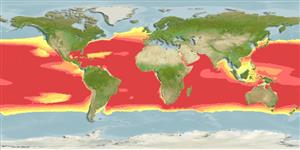Environment: milieu / climate zone / profondeur / distribution range
Écologie
marin bathypélagique; océanodrome (Ref. 51243); profondeur 50 - 1000 m (Ref. 58302), usually 100 - 400 m (Ref. 47377). Deep-water
Atlantic, Indian and Pacific: in central water areas.
Taille / Poids / Âge
Maturité: Lm ? range ? - ? cm
Max length : 18.5 cm SL mâle / non sexé; (Ref. 4058)
Description synthétique
Clés d'identification | Morphologie | Morphométrie
Épines dorsales (Total) : 0; Rayons mous dorsaux (Total) : 11 - 13; Épines anales: 0; Rayons mous anaux: 26 - 30. Color in alcohol, dark brown over body and fins (Ref. 4058). Well preserved specimens with a brassy-green iridescent layer along flanks, beneath eye and on cheeks (Ref. 4058).
Body shape (shape guide): elongated.
Oceanic and mesopelagic (Ref. 7300, 58302). Feeds on fish and sepia by preferring the latter (Ref. 47377).
Life cycle and mating behavior
Maturité | Reproduction | Frai | Œufs | Fécondité | Larves
Johnson, R.K., 1986. Evermannellidae. p. 278-280. In M.M. Smith and P.C. Heemstra (eds.) Smiths' sea fishes. Springer-Verlag, Berlin. (Ref. 4058)
Statut dans la liste rouge de l'IUCN (Ref. 130435: Version 2025-1)
Menace pour l'homme
Harmless
Utilisations par l'homme
Pêcheries: sans intérêt
Outils
Articles particuliers
Télécharger en XML
Sources Internet
Estimates based on models
Preferred temperature (Réf.
123201): 10.3 - 23, mean 15.3 °C (based on 756 cells).
Phylogenetic diversity index (Réf.
82804): PD
50 = 0.7539 [Uniqueness, from 0.5 = low to 2.0 = high].
Bayesian length-weight: a=0.00427 (0.00160 - 0.01136), b=3.12 (2.89 - 3.35), in cm total length, based on LWR estimates for this (Sub)family-body shape (Ref.
93245).
Niveau trophique (Réf.
69278): 4.4 ±0.57 se; based on food items.
Fishing Vulnerability (Ref.
59153): Low vulnerability (13 of 100).
🛈
